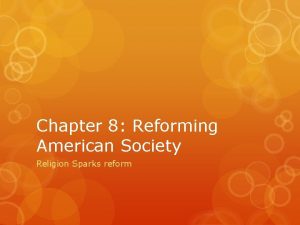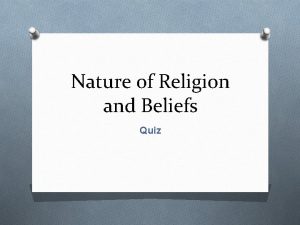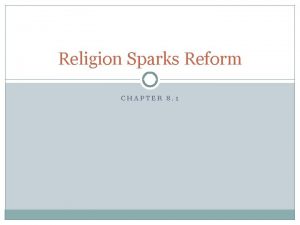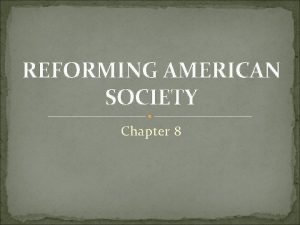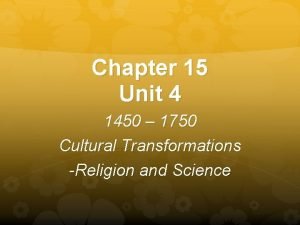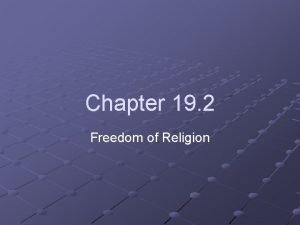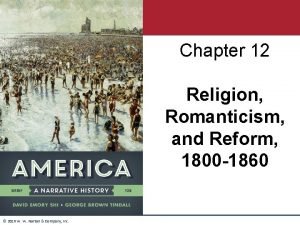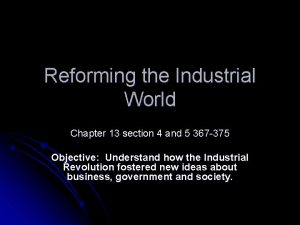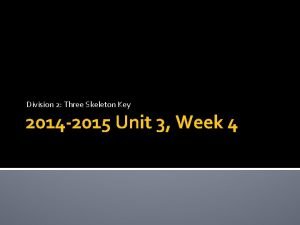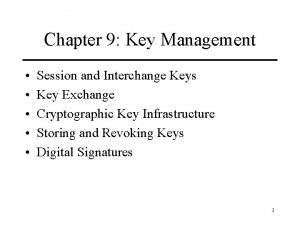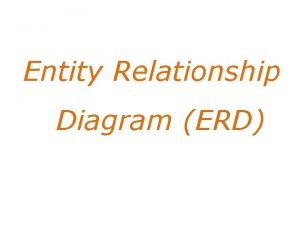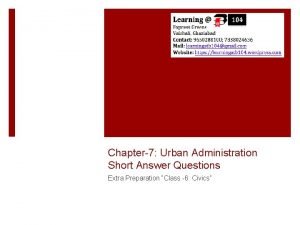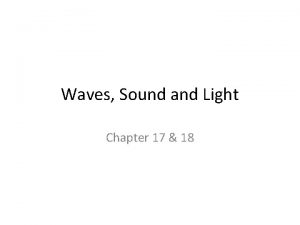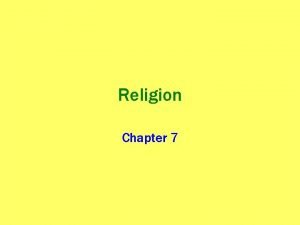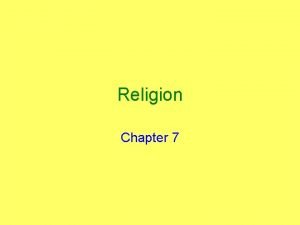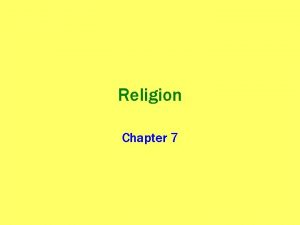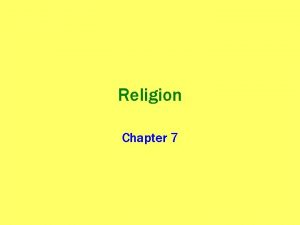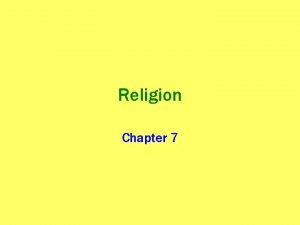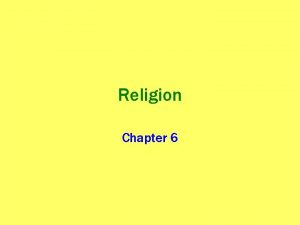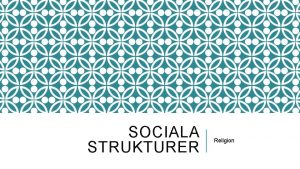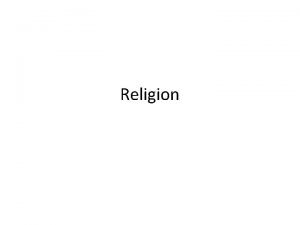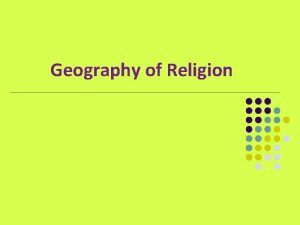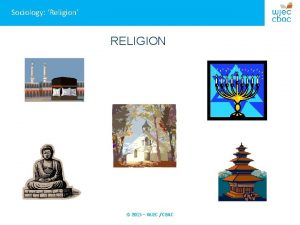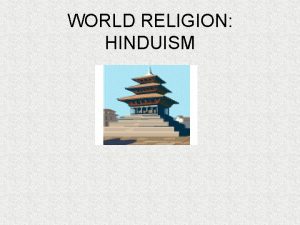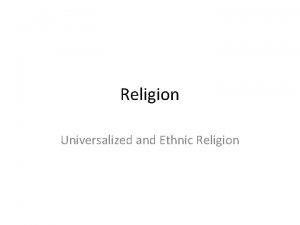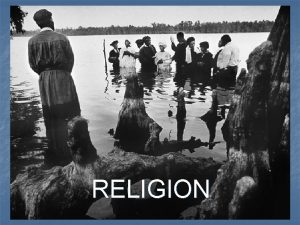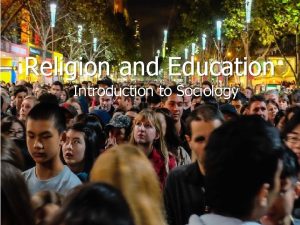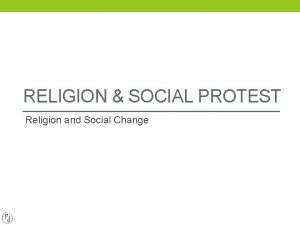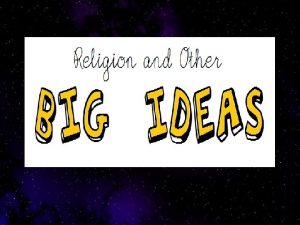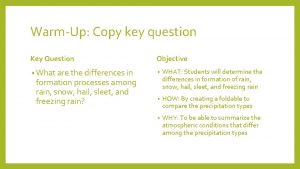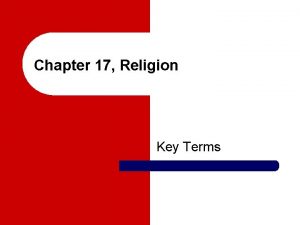Chapter 7 Religion Key Question What is religion








































- Slides: 40

Chapter 7: Religion

Key Question What is religion, and what role does it play in culture?

• According to Stoddard and Prorak, religion is “A system of beliefs and practices that attempts to order life in terms of culturally perceived ultimate priorities. ” • Religions set standards for how people “should” behave.

Religions manifests itself in many ways: • Worship • Prayer • Rituals • Take place through regular intervals • Birth, marriage, and death • Attainment of adulthood • Secularism is the indifference to or rejection of religion.

Describe how religion and language affect and change each other to shape cultures. Consider what happens to a society’s religion and language when a different religion or language diffuses to the place.

Key Question Where did the major religions of the world originate, and how do religions diffuse?

Where Did the Major Religions of the World Originate, and How Do Religions Diffuse? • Monotheistic religions: single god • Polytheistic religions: many gods • Animistic religions: inanimate objects possess spirits

Major types of religion • Universalizing religions: • Actively seek converts • Believe that they offer universal appropriateness and appeal • Usually have a prophet (founder) • Christianity, Islam, Buddhism • Ethnic religions: • Adherents are born into the faith • Do not actively seek converts • Tied more to physical enviroment • Spatially located, Judaism the exception • Shintoism, Hinduism



From the Hearth of South Asia Hinduism • One of oldest religions; over 4000 years • Originated in the Indus River Valley • Ganges (sacred river) • Ancient practices include ritual bathing and reincarnation • Polytheistic

The Vedas § 1200 BCE-600 BCE. § written in SANSKRIT. § Hindu core of beliefs: Rig Veda oldest work. Ø hymns and poems. Ø religious prayers. Ø magical spells. Ø lists of the gods and goddesses.

From the Hearth of South Asia Buddhism • Splintered from Hinduism 2500 years ago • Siddhartha • Approximately 347 million adherents Shintoism • Japan • Focused on nature and ancestor worship

From the Hearth of the Huang He River Valley Taoism • Lao-Tsu worship • Tao-te-ching • Feng Shui Confucianism • Confucius 551 to 479 BCE • Confucian Classics

From the Hearth of the Eastern Mediterranean Judaism • Teachings of Abraham • Orthodox and reformed Diffusion of Judaism • Diaspora • Zionism

From the Hearth of the Eastern Mediterranean Christianity • Teachings of Jesus • Split from Judaism • Church split led to Eastern Orthodox and Roman Catholic Church • Protestant reformation challenged fundamental Roman Catholic teachings

From the Hearth of the Eastern Mediterranean Diffusion of Christianity • European Colonialism in the sixteenth century • 33, 000 denominations


From the Hearth of the Eastern Mediterranean Islam • Founder Muhammad • Sacred text is the Qu’ran (Koran) • Five pillars of Islam • Shi’ite and Sunni

From the Hearth of the Eastern Mediterranean Diffusion of Islam • Kings used armies to spread faith across Arabian Peninsula. • Islam later spread by trade. • 1. 57 billion followers worldwide; is fastest-growing religion.


Indigenous and Shamanist • Indigenous – Local in scope – Reverence for nature – Passed down through tribes • Shamanism – Community faith – Follow the practices and teachings of the shaman

The Rise of Secularism • Indifference to or rejection of organized religious affiliations and idea • Varies greatly from country to country and within countries. • Antireligious ideologies can contribute to the decline of organized religions. • Church membership figures do not accurately reflect active participation.

Key Question How is religion seen in the cultural landscape?

Sacred sites • Places or spaces people infuse with religious meaning • Pilgrimage: Adherents voluntarily travel to a religious site to pay respects or participate in a ritual at the site Sacred Sites of Jerusalem • Sacred to Jews, Christians, and Muslims • Wailing Wall, Temple Mount, Dome of the Rock


Figure 7. 21 Jerusalem, Israel. The Church of the Holy Sepulchre is sacred to Christians who believe it is the site where Jesus Christ rose from the dead. Inside the church, a Christian worshipper lights a candle at Jesus Christ’s tomb. © Reuters/Corbis Images.

Landscapes of Hinduism and Buddhism • Hinduism • Temples, shrines • Holy animals, ritual bathing • Buddhism • The Bodhi (enlightenment) tree • Stupus: bell shaped structures that protect burial mounds • Pagoda Cremation in both Hinduism in Buddhism

Landscapes of Christianity • Medieval Europe • Cathedral, church, or monastery • Burial more commonly practiced Figure 7. 25 Bordeaux, France. Built beginning in 1472, St. Michael’s Tower rises over Bordeaux, France, marking the importance of the Catholic Church in Bordeaux’s history and culture. © H. J. de Blij.

Landscapes of Christianity Religious Landscapes in the United States Zelinsky: Map identifying religious regions of the United States New England: Catholic South: Baptist Upper Midwest: Lutheran Southwest: Spanish Catholic West, Midlands: no dominant denomination

Figure 7. 28 Major Religious Regions of the United States. A generalized map of the religious regions of the United States shows concentrations of the major religions. Adapted with permission from: W. Zelinsky, The Cultural Geography of the United States, rev. ed. , Englewood Cliffs, NJ: Prentice Hall, 1992, p. 96.

Landscapes of Islam • Alhambra Palace in Granada • Great Mosque of Cordoba, Spain • Prohibition against depicting the human form • Led to calligraphy and geometric design use • Hajj • Pilgrimage to Mecca

Figure 7. 33 Mecca, Saudi Arabia. Pilgrims circle the holy Kaaba in the Grand Mosque in Mecca during the hajj. © Amel Emric/AP/Wide World Photos.

Key Question What role does religion play in political conflicts?

Conflicts along Religious Borders • Interfaith boundaries: boundaries between the world’s major faiths • Ex. : Christian-Muslim boundaries in Africa • Intrafaith boundaries: boundaries within a single major faith • Ex. : Christian Protestants and Catholics, Muslim Sunni and Shi’ite

Figure 7. 36 The West Bank. Adapted with permission from: C. B. Williams and C. T. Elsworth, The New. York Times, November 17, 1995, p. A 6. © The New York Times.

What Role Does Religion Play in Political Conflicts? Israel and Palestine • WWII, 1967 Arab-Israeli War, West Bank, Hamas Nigeria • Muslim North/Christian South The Former Yugoslavia • Balkan Peninsula separates the Roman Catholic Chruch and the Eastern Orthodox Church Northern Ireland • Catholics and Protestants in the North

Figure 7. 39 Religious Affiliation in Northern Ireland. Areas of Catholic and Protestant majorities are scattered throughout Northern Ireland. Adapted with permission from: D. G. Pringle, One Island, Two Nations? Letchworth: Research. Studies Press/Wiley, 1985, p. 21.

Religious Fundamentalism and Extremism • Religious fundamentalism • Beliefs are nonnegotiable and uncompromising • Religious extremism • Fundamentalism carried to the point of violence • Fundamentalists can be extremists but this does not mean that all fundamentalists (of any faith) are extremists

Religious Fundamentalism and Extremism Christianity • Traditionalist Catholic Movement • Protestant fundamentalism Judaism • Orthodox conservatives • Extremist groups Kach and Kahane Chai Islam • Jihad: Taliban in Afghanistan
 3 levels of questions
3 levels of questions Chapter 8 section 1 religion sparks reform answer key
Chapter 8 section 1 religion sparks reform answer key Western religion vs eastern religion
Western religion vs eastern religion Key partners business model
Key partners business model Key partners key activities key resources
Key partners key activities key resources Question about religion
Question about religion Question word simple present
Question word simple present Closed question
Closed question Contoh open ended question adalah
Contoh open ended question adalah Factor isolating questions in research
Factor isolating questions in research Direct questions into indirect questions
Direct questions into indirect questions Compelling and supporting questions
Compelling and supporting questions Compelling and supporting questions
Compelling and supporting questions Semantics - exercises with answers
Semantics - exercises with answers Chapter 11 stoichiometry test
Chapter 11 stoichiometry test Similarity ratio definition
Similarity ratio definition Chapter 7 ionic and metallic bonding chapter answer key
Chapter 7 ionic and metallic bonding chapter answer key Chapter 9 surface water answer key
Chapter 9 surface water answer key Chapter 7 ionic and metallic bonding assessment answer key
Chapter 7 ionic and metallic bonding assessment answer key Chapter 4 section 1 population dynamics study guide
Chapter 4 section 1 population dynamics study guide Chapter 8 section 1 religion sparks reform
Chapter 8 section 1 religion sparks reform Chapter 8 section 1 religion sparks reform
Chapter 8 section 1 religion sparks reform Religion sparks reform
Religion sparks reform Chapter 15 cultural transformations
Chapter 15 cultural transformations Chapter 19 section 2 freedom of religion
Chapter 19 section 2 freedom of religion Chapter 12: religion, romanticism, and reform, 1800–1860
Chapter 12: religion, romanticism, and reform, 1800–1860 Reforming the industrial world chapter 9 section 4
Reforming the industrial world chapter 9 section 4 Chapter 4 lesson 4 metamorphic rocks answer key
Chapter 4 lesson 4 metamorphic rocks answer key Dichotomous key
Dichotomous key Lesson 1 waves answer key
Lesson 1 waves answer key Three skeleton key plot diagram
Three skeleton key plot diagram Session key vs interchange key
Session key vs interchange key Apa itu entity relationship diagram
Apa itu entity relationship diagram Chapter 16
Chapter 16 Chapter 7 urban administration question answer
Chapter 7 urban administration question answer Vocation chapter question answer
Vocation chapter question answer Night section 1 quiz
Night section 1 quiz Working with young children chapter 1
Working with young children chapter 1 Glue
Glue Chapter 17 mechanical waves and sound wordwise answer key
Chapter 17 mechanical waves and sound wordwise answer key The wave chapter 15
The wave chapter 15

